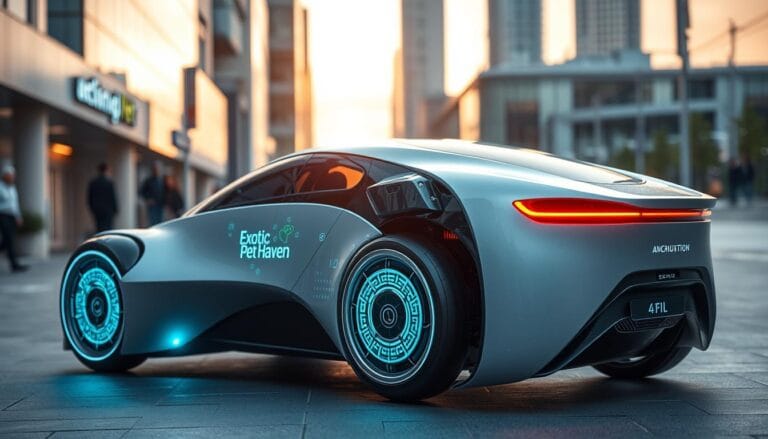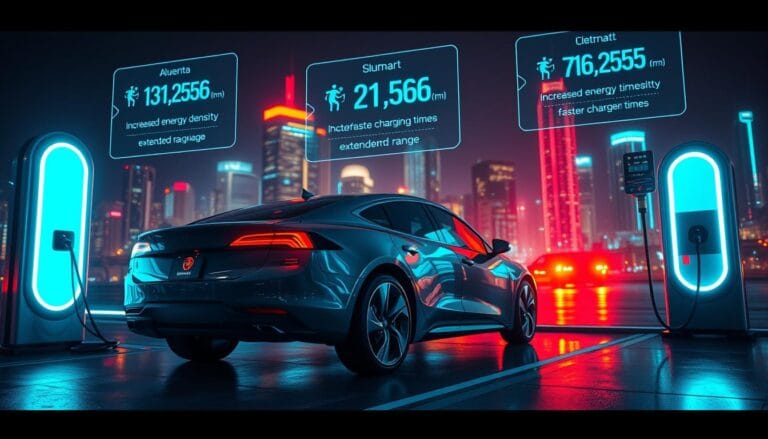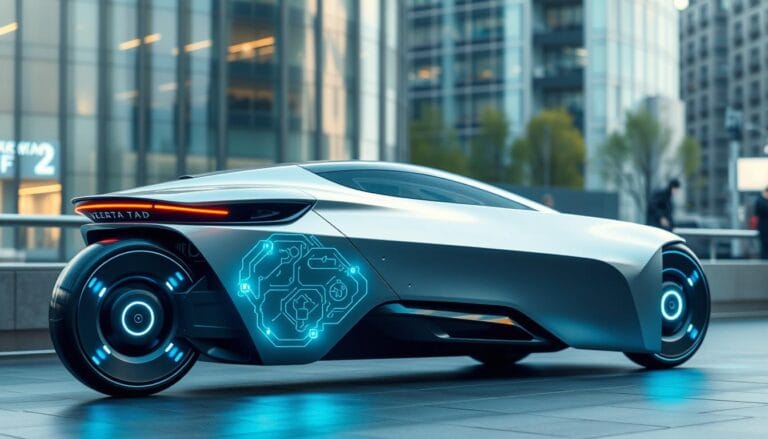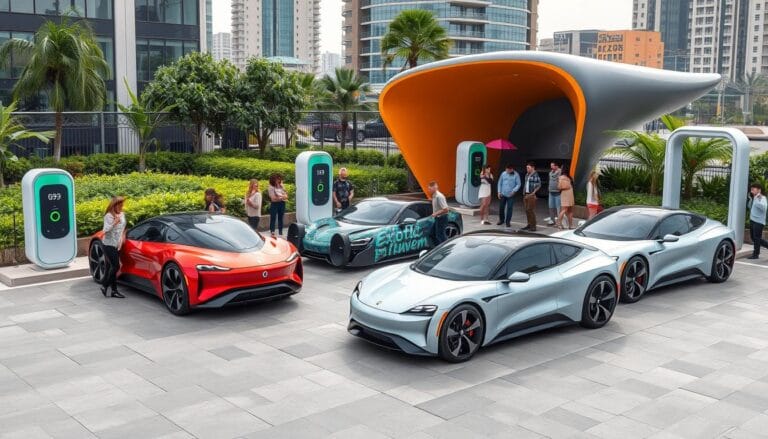Electric Vehicle Trends 2025: What’s Driving the Future?
Imagine driving a sleek electric car, moving quietly down the road with no pollution. The future of cars is changing, and you’re about to see why it’s a big deal.
The car world is changing fast. Soon, up to 25% of new cars will be electric. In 2024, over 1.3 million electric cars were sold in the U.S. California is leading with over 2 million electric vehicles.
So, what’s behind this big change? It’s a mix of new tech, caring for the planet, and saving money. Batteries are getting better, charging times are shorter, and owning an electric car is becoming more affordable.
Table of Contents
The Rise of Electric Vehicles in the U.S. Market
The electric vehicle (EV) scene in the United States is changing fast. More people are choosing EVs, which is changing the car world. In 2024, the EV market is growing strong and showing a lot of promise.
Recent numbers show interesting facts about EVs. In February, 95,692 EVs were sold, up 10.5% from last year. Even though their market share dropped to 7.7%, the trends are good.
Current Market Share and Sales Performance
- Top 5 selling EV models:
- Tesla Model Y
- Tesla Model 3
- Ford Mustang Mach-E
- Honda Prologue
- Rivian R1S
- Luxury brands like BMW and Rivian saw significant sales increases
- Average transaction price for new EVs: $55,273
Key Players Driving Innovation
EVs are becoming more affordable, with incentives making up 14.9% of the price. Luxury brands and new players are making EVs more appealing to buyers.
Consumer Adoption Trends
Cox Automotive sees a bright future for EVs. By 2025, electric and hybrid cars will make up 25% of U.S. sales. Pure EVs will hit 10% of the market. This year, 15 new electric models will hit the market, giving buyers more choices.
The EV market is not just growing—it’s evolving rapidly, with more options and better value for consumers.
Charging stations are growing, up 40% in two years. Tesla’s North American Charging Standard will make charging easier, making EVs more convenient than ever.
Advancements in Battery Technology
The electric vehicle industry is seeing big changes in battery tech. As the global EV market is set to hit $1 trillion by 2029, new innovations are changing how we think about green transport. These advancements are making electric vehicles do more than ever before.
New battery designs are opening up new possibilities for electric cars. The growth rate of 6.63% from 2024 to 2029 shows how important these new techs are.
The Shift to Solid-State Batteries
Solid-state batteries are a big deal in EVs. Toyota plans to start using them by 2026, with full production by 2030. They offer:
- Improved safety over traditional lithium-ion batteries
- Longer driving ranges
- Less chance of overheating
- More energy stored
Comparing Battery Technologies
Battery tech is evolving fast, bringing new green transport solutions. Here’s a look at some new battery types:
| Battery Type | Energy Density | Range | Charging Speed |
|---|---|---|---|
| Lithium-Ion | Standard | 310 miles | Moderate |
| Solid-State | High | Potential 400+ miles | Faster |
| Silicon Anode | Very High | 547 miles | Improved |
Impact on EV Range and Charging
New battery tech is making electric cars better. Tesla’s new 4680 cell design boosts energy density by 16%. Silicon anode batteries could make driving even longer. These changes are key to making electric cars more appealing to everyone.
Charging Infrastructure Developments
The electric vehicle charging world is changing fast. This change is making it easier for Americans to use green transportation. Governments, companies, and tech leaders are all working hard to improve this area.
The U.S. is seeing a big growth in charging stations. This growth is thanks to government plans and private money. The Bipartisan Infrastructure Law has set aside $7.5 billion for EV charging. The goal is to add 500,000 new stations by 2030.
Tesla Supercharger Access: Breaking Barriers
In 2025, Tesla made a big change. They decided to let other car brands use their Supercharger network. This makes it easier for people to charge their cars, no matter what brand they have.
- Ultra-fast chargers can recharge an EV battery to 80% in just 20 minutes
- Charging speeds reaching up to 350 kW
- Expanded network coverage for long-distance travelers
Nationwide Charging Station Expansion
Charging stations are now going up everywhere, not just in cities. This is helping to fix a problem in rural areas. Governments and companies are working together to put stations in more places.
| Charging Location Type | Projected Growth by 2025 |
|---|---|
| Parking Lots | 45% increase |
| Workplaces | 38% increase |
| Residential Complexes | 52% increase |
| Rural Public Spaces | 35% increase |
Innovations in Fast-Charging Technology
The future of EV charging is exciting. New tech, like AI, is going to make charging better. We can expect to see prices change based on demand and less time waiting for a charge.
By 2025, the global EV charging infrastructure market is projected to reach US$104 billion, signaling a transformative era in sustainable transportation.
Key Events in the Electric Vehicle Industry
The electric vehicle world is changing fast, with big steps set for 2025. As Electric Vehicle Trends 2025 speed up, we see big changes. These changes will change how we move around.

Anticipating the KGM Musso EV Launch
The car world is excited for the KGM Musso EV. This electric car is a big step in Government Incentives for EVs. It shows how car makers are meeting market needs.
Experts think the launch will bring new features. These could shake up the EV market.
Major Conferences Driving Innovation
Important conferences are key for new tech. These events gather:
- Global EV makers
- Battery tech innovators
- Policy makers
- Sustainability experts
Legislative Changes Impact EV Ecosystem
New laws are changing the electric vehicle scene. The rules are getting better for EVs through smart policies.
| Policy Area | Expected Impact |
|---|---|
| Tax Incentives | More money for buying EVs |
| Charging Infrastructure | More charging spots everywhere |
| Environmental Regulations | Tighter emissions rules |
Keeping up with these events helps you understand Electric Vehicle Trends 2025. It helps you make smart choices in the changing car world.
Government Initiatives Supporting EV Adoption
The world of electric vehicles is changing fast, thanks to government help. In 2024, new rules at the federal and state levels are making it easier for people to buy EVs.
The U.S. government has set up several big incentives to boost EV sales:
- Federal tax credit of up to $7,500 for qualifying EV purchases
- Direct dealer transfer options for tax credits
- State-specific rebate programs
Federal Incentives for Electric Vehicle Buyers
Now, buying an EV is more appealing than ever. In 2024, over 300,000 electric and plug-in hybrid vehicles were bought with federal tax credits. This new system lets buyers transfer credits to dealerships, cutting down costs.
State-Level Policies and Impact
States are getting creative to encourage more people to buy EVs. Some offer extra tax breaks, while others let EVs use HOV lanes and lower registration fees. These local efforts add to the federal help, making EVs more affordable.
Impact of Environmental Regulations
Environmental rules are changing the car industry a lot. The Zero-Emission Vehicle mandate wants 80% of new cars and 70% of vans to be zero-emissions by 2030. This push is moving both car makers and buyers toward greener options.
By 2024, EVs represent one in five cars sold globally, showing how fast electric vehicles are becoming popular.
The Rise of Sustainable Manufacturing Practices
The automotive industry is changing fast. Now, making cars that are good for the planet is key. Electric car makers are making vehicles that are not only green but also cool for those who care about the environment.
The car world is moving towards making things better for our planet. Companies are working hard to cut down on pollution. They’re using new ways to make cars that are kinder to our Earth.
Eco-Friendly Production Techniques
Big car makers are trying new things to make cars better:
- They’re using clean energy in their factories.
- They’re making production lines that waste nothing.
- They’re using less water when they put cars together.
- They’re cutting down on pollution in their making process.
The Role of Recyclable Materials
People want cars made from stuff that’s good for the planet. Car makers are using new, recyclable parts in their cars:
- They’re starting programs to recycle car batteries.
- They’re using old materials in car interiors.
- They’re making systems that use the same materials over and over.
How Sustainability Appeals to Consumers
More and more people want cars that are good for the planet. A survey by the Global EV Alliance found that over 90% of electric car owners want to buy another one. This shows they really care about cars that are kind to the Earth.
The future of making cars is all about being green, efficient, and listening to what people want.
By focusing on being green, car makers are doing more than just helping the planet. They’re making cars that appeal to today’s buyers who want cars that are made responsibly and look cool.
The Integration of AI and Smart Technology
The future of electric vehicles is changing fast thanks to AI and smart tech. As we move into 2025, you’ll see smart systems that change how we drive. These systems are making driving better than ever.
Smart Features Enhancing the Driving Experience
Autonomous driving is changing how we use our cars. Today’s electric vehicles have smart features that get to know you. They make driving personal and easy to use.
- Real-time route optimization
- Adaptive energy management
- Predictive maintenance alerts
- Personalized driving assistance
The Role of Data Analytics in Optimizing EV Performance
Data analytics is key to making electric vehicles better. By using smart algorithms, makers can improve your EV’s performance. This makes your car work better for you.
| Performance Metric | AI Impact |
|---|---|
| Battery Efficiency | Improved range prediction |
| Charging Optimization | Grid-aware charging schedules |
| Energy Management | Real-time power distribution |
Future Innovations to Watch For
The smart e-Drive market is growing fast. It’s expected to hit USD 9.4 Billion by 2030 with a 29.3% growth rate. New tech will change how we drive.
- Advanced computer vision systems
- AI-powered predictive maintenance
- Vehicle-to-grid communication
- Intelligent crash prevention technologies
By 2025, nearly 60% of cars will feature advanced autonomous capabilities, marking a significant leap in smart vehicle technology.
The Impact of EVs on Travel and Commuting
Electric vehicles are changing how we travel, making it more sustainable. They are making city driving and long trips better. More people are choosing EVs, changing how we move around.
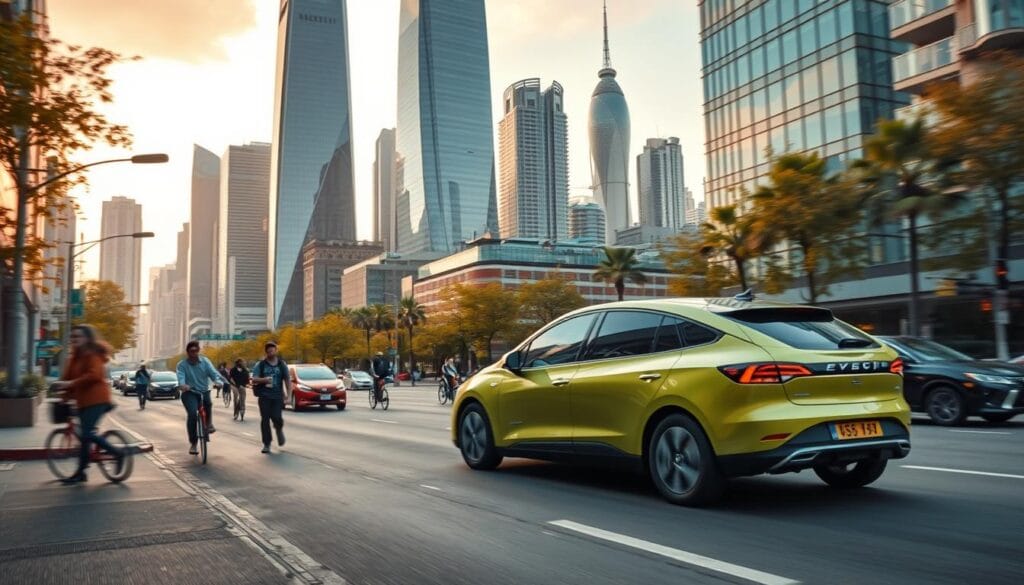
Electric cars are not just a trend; they’re changing how cities move. They help cut down on pollution and make the air cleaner. This is a big change for city travel.
Urban Transportation Reimagined
Electric vehicles are opening up new ways to travel in cities. Some key changes include:
- Less noise pollution
- Lower carbon emissions
- Cleaner air in big cities
- Better public transport
Long-Distance EV Travel Expectations
By 2025, traveling long distances in EVs will be very different. New tech is making EVs go much farther, up to 700 miles on one charge.
| EV Travel Metric | 2024 Status | 2025 Projection |
|---|---|---|
| Average Vehicle Range | 250-350 miles | 500-700 miles |
| Charging Time | 45-60 minutes | 20-30 minutes |
| Charging Station Availability | Limited networks | Expanded nationwide coverage |
Consumer Behavior Shifts
Buying an electric car is changing how people travel. Drivers are getting used to new habits, like:
- Planning routes better
- Using charging stations
- Knowing how far they can go
- Using smart charging tech
More than 40% of drivers are thinking about getting an EV next. Workplace charging is growing fast. The electric car movement is really taking off.
What This Means for Drivers in 2025
The electric vehicle world is changing fast. Trends for 2025 show EVs will be more common and affordable for drivers in America. You’ll see big changes in how EVs fit into your daily life, like their cost.
By 2025, owning an EV will save you money. EVs cost 40% less to maintain than gas cars. Plus, tax credits make them cheaper, with many models under $40,000. You’ll also find more charging spots, making long trips easier.
Your charging habits will change a lot. New systems give you real-time info on charging stations. You’ll enjoy features like hands-free connectivity and settings tailored just for you. As more people buy EVs, you’ll join a growing community.
The future of road trips is electric. New battery tech means longer drives and quick charging. Even your car can power your home during outages. The electric car era is already here.


